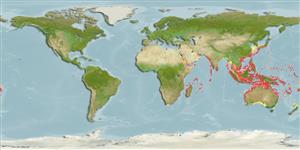Actinopterygii (ray-finned fishes) >
Perciformes (Perch-likes) >
Carangidae (Jacks and pompanos) > Caranginae
Etymology: Carangoides: French, carangue, the name of a Caribbean fish; 1836 (Ref. 45335).
Environment / Climate / Range
Ecology
Marine; brackish; reef-associated; depth range 30 - 60 m (Ref. 11441). Tropical, preferred ?; 37°N - 41°S, 20°E - 178°W
Indo-Pacific: East Africa (Ref. 3287) to Fiji, north to Ryukyu Islands, south to New Zealand.
Size / Weight / Age
Maturity: Lm ? range ? - ? cm
Max length : 72.0 cm FL male/unsexed; (Ref. 40637); common length : 65.0 cm TL male/unsexed; (Ref. 5450); max. published weight: 4.4 kg (Ref. 40637)
Dorsal
spines
(total): 9;
Dorsal
soft rays
(total): 18-20;
Anal
spines: 3;
Anal
soft rays: 14 - 17. Color silvery, greenish above. Opercle with black spot. 20-37 weak scutes. Pectoral fins falcate. Scaleless breast to behind pelvic origin and laterally to pectoral base. Soft dorsal lobe falcate in young, becoming shorter than head in adults. First 2 anal spines detached.
Adults inhabit open waters of coastal reefs (Ref. 9710). Juveniles occur in inshore areas, including estuaries (Ref. 3287). Usually in small groups (Ref. 48635).
Life cycle and mating behavior
Maturity | Reproduction | Spawning | Eggs | Fecundity | Larvae
Paxton, J.R., D.F. Hoese, G.R. Allen and J.E. Hanley, 1989. Pisces. Petromyzontidae to Carangidae. Zoological Catalogue of Australia, Vol. 7. Australian Government Publishing Service, Canberra, 665 p. (Ref. 7300)
IUCN Red List Status (Ref. 115185)
CITES (Ref. 94142)
Not Evaluated
Threat to humans
Harmless
Human uses
Fisheries: commercial; gamefish: yes
More information
Common namesSynonymsMetabolismPredatorsEcotoxicologyReproductionMaturitySpawningFecundityEggsEgg development
ReferencesAquacultureAquaculture profileStrainsGeneticsAllele frequenciesHeritabilityDiseasesProcessingMass conversion
Tools
Special reports
Download XML
Internet sources
